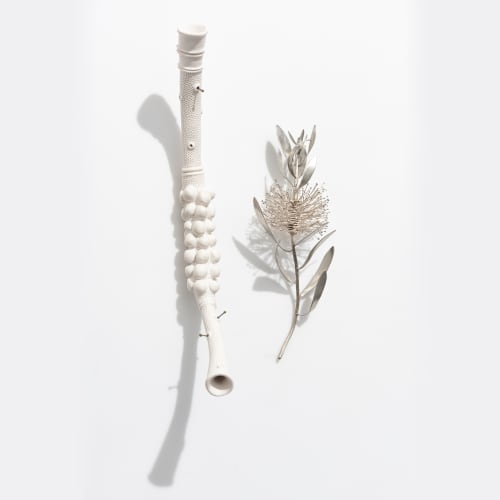Anthologia is a Greek word that literally means ‘flower gathering’; its English translation, ‘anthology’ denotes a collection of literary works such as poems, short stories or plays. Both definitions are meaningful in considering the work of artists Sarah Rayner and Sophie Carnell. Over the past two decades both artists have established singular and highly regarded practices, characterised by their close observation of native flora and fidelity to materials. It is perhaps not surprising then that the pair should become friends and collaborators. Yet the artists live and work more than 2,500 km apart, responding to significantly different ecologies through divergent approaches and media.
The life cycle of plants has been the principal focus of Sarah Rayner’s practice since her first exhibition in 1997. Her ongoing commitment to the subject is evident throughout her oeuvre, from early textile works to more recent ceramic objects and installations. Its most recent iteration is the artist’s ceramic series ‘Flowerbones’, sculptural re-imaginings of the sex organs of native Australian plants, crafted in delicate white porcelain clay. Their forms are based on fallen fruit and seedpods, the byproducts of plant reproduction, that the artist collects on her property near Maleny, in the Sunshine Coast hinterland. Ready access to these materials allows Rayner to undertake close and sustained observation, informing the research and development of her objects.
Carnell spends hours walking the coastal shoreline and surrounds near her home at Barnes Bay on the northern end of Bruny, observing the rich local plant life including various species of Tasmanian orchids. Smaller than their better-known, exotic counterparts, native orchids flower only for brief periods and are easily overlooked, hidden amongst the leaf litter. Carnell draws attention to these plants by producing them in delicate yet robust silver. Like Rayner ‘s ‘Flowerbones’, Carnell’s orchids are larger than the real thing, encouraging viewers to ‘look closer at the plants and consider the unseen’ . The artist delineates the root structures and corms of the plant by oxidizing the silver, causing it to blacken; while the above ground parts of the plant, the stem and florets, are polished. Carnell’s orchids have an anthropomorphic quality, appearing to stand or rest on their base; this is reinforced by their depiction of the corms, which resemble the reproductive organs of the male anatomy.
Anthologia, collects Carnell’s and Rayner’s individual and shared responses to their subject matter. It presents them in such a way as to facilitate an appreciation of their similarities, as well as highlighting how each of their responses is unique. Both artists make work that speaks to the complexity and richness of native flora however they are not faithful representations. Instead, they are subjective interpretations that foreground the precariousness of our finely balanced ecosystem.



